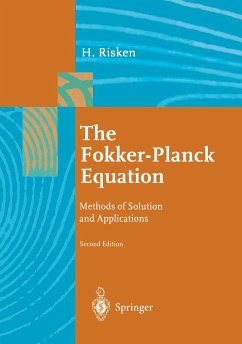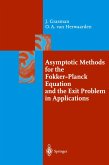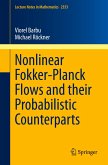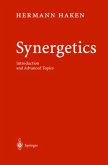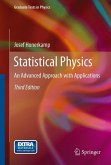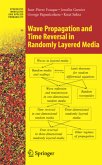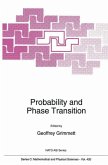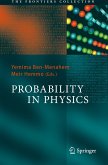- Broschiertes Buch
- Merkliste
- Auf die Merkliste
- Bewerten Bewerten
- Teilen
- Produkt teilen
- Produkterinnerung
- Produkterinnerung
One of the central problems synergetics is concerned with consists in the study of macroscopic qualitative changes of systems belonging to various disciplines such as physics, chemistry, or electrical engineering. When such transitions from one state to another take place, fluctuations, i.e., random processes, may play an im portant role. Over the past decades it has turned out that the Fokker-Planck equation pro vides a powerful tool with which the effects of fluctuations close to transition points can be adequately treated and that the approaches based on the Fokker Planck equation are…mehr
Andere Kunden interessierten sich auch für
![Asymptotic Methods for the Fokker-Planck Equation and the Exit Problem in Applications Asymptotic Methods for the Fokker-Planck Equation and the Exit Problem in Applications]() Johan GrasmanAsymptotic Methods for the Fokker-Planck Equation and the Exit Problem in Applications39,99 €
Johan GrasmanAsymptotic Methods for the Fokker-Planck Equation and the Exit Problem in Applications39,99 €![Nonlinear Fokker-Planck Flows and their Probabilistic Counterparts Nonlinear Fokker-Planck Flows and their Probabilistic Counterparts]() Viorel BarbuNonlinear Fokker-Planck Flows and their Probabilistic Counterparts45,99 €
Viorel BarbuNonlinear Fokker-Planck Flows and their Probabilistic Counterparts45,99 €![Synergetics Synergetics]() Hermann HakenSynergetics86,99 €
Hermann HakenSynergetics86,99 €![Statistical Physics Statistical Physics]() Josef HonerkampStatistical Physics56,99 €
Josef HonerkampStatistical Physics56,99 €![Wave Propagation and Time Reversal in Randomly Layered Media Wave Propagation and Time Reversal in Randomly Layered Media]() Jean-Pierre FouqueWave Propagation and Time Reversal in Randomly Layered Media71,99 €
Jean-Pierre FouqueWave Propagation and Time Reversal in Randomly Layered Media71,99 €![Probability and Phase Transition Probability and Phase Transition]() G.R. Grimmett (Hrsg.)Probability and Phase Transition115,99 €
G.R. Grimmett (Hrsg.)Probability and Phase Transition115,99 €![Probability in Physics Probability in Physics]() Probability in Physics38,99 €
Probability in Physics38,99 €-
-
-
One of the central problems synergetics is concerned with consists in the study of macroscopic qualitative changes of systems belonging to various disciplines such as physics, chemistry, or electrical engineering. When such transitions from one state to another take place, fluctuations, i.e., random processes, may play an im portant role. Over the past decades it has turned out that the Fokker-Planck equation pro vides a powerful tool with which the effects of fluctuations close to transition points can be adequately treated and that the approaches based on the Fokker Planck equation are superior to other approaches, e.g., based on Langevin equa tions. Quite generally, the Fokker-Planck equation plays an important role in problems which involve noise, e.g., in electrical circuits. For these reasons I am sure that this book will find a broad audience. It pro vides the reader with a sound basis for the study of the Fokker-Planck equation and gives an excellent survey of the methodsof its solution. The author of this book, Hannes Risken, has made substantial contributions to the development and application of such methods, e.g., to laser physics, diffusion in periodic potentials, and other problems. Therefore this book is written by an experienced practitioner, who has had in mind explicit applications to important problems in the natural sciences and electrical engineering.
Hinweis: Dieser Artikel kann nur an eine deutsche Lieferadresse ausgeliefert werden.
Hinweis: Dieser Artikel kann nur an eine deutsche Lieferadresse ausgeliefert werden.
Produktdetails
- Produktdetails
- Springer Series in Synergetics 18
- Verlag: Springer / Springer Berlin Heidelberg / Springer, Berlin
- Artikelnr. des Verlages: 978-3-540-61530-9
- 2nd ed. repr.
- Seitenzahl: 488
- Erscheinungstermin: 17. September 1996
- Englisch
- Abmessung: 242mm x 170mm x 27mm
- Gewicht: 706g
- ISBN-13: 9783540615309
- ISBN-10: 354061530X
- Artikelnr.: 04732491
- Herstellerkennzeichnung Die Herstellerinformationen sind derzeit nicht verfügbar.
- Springer Series in Synergetics 18
- Verlag: Springer / Springer Berlin Heidelberg / Springer, Berlin
- Artikelnr. des Verlages: 978-3-540-61530-9
- 2nd ed. repr.
- Seitenzahl: 488
- Erscheinungstermin: 17. September 1996
- Englisch
- Abmessung: 242mm x 170mm x 27mm
- Gewicht: 706g
- ISBN-13: 9783540615309
- ISBN-10: 354061530X
- Artikelnr.: 04732491
- Herstellerkennzeichnung Die Herstellerinformationen sind derzeit nicht verfügbar.
1. Introduction.- 1.1 Brownian Motion.- 1.2 Fokker-Planck Equation.- 1.3 Boltzmann Equation.- 1.4 Master Equation.- 2. Probability Theory.- 2.1 Random Variable and Probability Density.- 2.2 Characteristic Function and Cumulants.- 2.3 Generalization to Several Random Variables.- 2.4 Time-Dependent Random Variables.- 2.5 Several Time-Dependent Random Variables.- 3. Langevin Equations.- 3.1 Langevin Equation for Brownian Motion.- 3.2 Ornstein-Uhlenbeck Process.- 3.3 Nonlinear Langevin Equation, One Variable.- 3.4 Nonlinear Langevin Equations, Several Variables.- 3.5 Markov Property.- 3.6 Solutions of the Langevin Equation by Computer Simulation.- 4. Fokker-Planck Equation.- 4.1 Kramers-Moyal Forward Expansion.- 4.2 Kramers-Moyal Backward Expansion.- 4.3 Pawula Theorem.- 4.4 Fokker-Planck Equation for One Variable.- 4.5 Generation and Recombination Processes.- 4.6 Application of Truncated Kramers-Moyal Expansions.- 4.7 Fokker-Planck Equation for N Variables.- 4.8 Examples for Fokker-Planck Equations with Several Variables.- 4.9 Transformation of Variables.- 4.10 Covariant Form of the Fokker-Planck Equation.- 5. Fokker-Planck Equation for One Variable; Methods of Solution.- 5.1 Normalization.- 5.2 Stationary Solution.- 5.3 Ornstein-Uhlenbeck Process.- 5.4 Eigenfunction Expansion.- 5.5 Examples.- 5.6 Jump Conditions.- 5.7 A Bistable Model Potential.- 5.8 Eigenfunctions and Eigenvalues of Inverted Potentials.- 5.9 Approximate and Numerical Methods for Determining Eigenvalues and Eigenfunctions.- 5.10 Diffusion Over a Barrier.- 6. Fokker-Planck Equation for Several Variables; Methods of Solution.- 6.1 Approach of the Solutions to a Limit Solution.- 6.2 Expansion into a Biorthogonal Set.- 6.3 Transformation of the Fokker-Planck Operator, Eigenfunction Expansions.- 6.4 Detailed Balance.- 6.5 Ornstein-Uhlenbeck Process.- 6.6 Further Methods for Solving the Fokker-Planck Equation.- 7. Linear Response and Correlation Functions.- 7.1 Linear Response Function.- 7.2 Correlation Functions.- 7.3 Susceptibility.- 8. Reduction of the Number of Variables.- 8.1 First-Passage Time Problems.- 8.2 Drift and Diffusion Coefficients Independent of Some Variables.- 8.3 Adiabatic Elimination of Fast Variables.- 9. Solutions of Tridiagonal Recurrence Relations, Application to Ordinary and Partial Differential Equations.- 9.1 Applications and Forms of Tridiagonal Recurrence Relations.- 9.2 Solutions of Scalar Recurrence Relations.- 9.3 Solutions of Vector Recurrence Relations.- 9.4 Ordinary and Partial Differential Equations with Multiplicative Harmonic Time-Dependent Parameters.- 9.5 Methods for Calculating Continued Fractions.- 10. Solutions of the Kramers Equation.- 10.1 Forms of the Kramers Equation.- 10.2 Solutions for a Linear Force.- 10.3 Matrix Continued-Fraction Solutions of the Kramers Equation.- 10.4 Inverse Friction Expansion.- 11. Brownian Motion in Periodic Potentials.- 11.1 Applications.- 11.2 Normalization of the Langevin and Fokker-Planck Equations.- 11.3 High-Friction Limit.- 11.4 Low-Friction Limit.- 11.5 Stationary Solutions for Arbitrary Friction.- 11.6 Bistability between Running and Locked Solution.- 11.7 Instationary Solutions.- 11.8 Susceptibilities.- 11.9 Eigenvalues and Eigenfunctions.- 12. Statistical Properties of Laser Light.- 12.1 Semiclassical Laser Equations.- 12.2 Stationary Solution and Its Expectation Values.- 12.3 Expansion in Eigenmodes.- 12.4 Expansion into a Complete Set; Solution by Matrix Continued Fractions.- 12.5 Transient Solution.- 12.6 Photoelectron Counting Distribution.- Appendices.- A1 Stochastic Differential Equations with Colored Gaussian Noise.- A2 Boltzmann Equation with BGK and SW Collision Operators.- A3 Evaluation of a Matrix Continued Fraction for the Harmonic Oscillator.- A4 Damped Quantum-Mechanical Harmonic Oscillator.- A5 Alternative Derivation of the Fokker-Planck Equation.- A6 Fluctuating Control Parameter.- S. Supplement to the Second Edition.- S.1 Solutions of the Fokker-Planck Equation by Computer Simulation (Sect. 3.6).- S.2 Kramers-Moyal Expansion (Sect. 4.6).- S.3 Example for the Covariant Form of the Fokker-Planck Equation (Sect. 4.10).- S.4 Connection to Supersymmetry and Exact Solutions of the One Variable Fokker-Planck Equation (Chap. 5).- S.5 Nondifferentiability of the Potential for the Weak Noise Expansion (Sects. 6.6 and 6.7).- S.6 Further Applications of Matrix Continued-Fractions (Chap. 9).- S.7 Brownian Motion in a Double-Well Potential (Chaps. 10 and 11).- S.8 Boundary Layer Theory (Sect. 11.4).- S.9 Calculation of Correlation Times (Sect. 7.12).- S.10 Colored Noise (Appendix A1).- S.11 Fokker-Planck Equation with a Non-Positive-Definite Diffusion Matrix and Fokker-Planck Equation with Additional Third-Order-Derivative Terms.- References.
1. Introduction.- 1.1 Brownian Motion.- 1.2 Fokker-Planck Equation.- 1.3 Boltzmann Equation.- 1.4 Master Equation.- 2. Probability Theory.- 2.1 Random Variable and Probability Density.- 2.2 Characteristic Function and Cumulants.- 2.3 Generalization to Several Random Variables.- 2.4 Time-Dependent Random Variables.- 2.5 Several Time-Dependent Random Variables.- 3. Langevin Equations.- 3.1 Langevin Equation for Brownian Motion.- 3.2 Ornstein-Uhlenbeck Process.- 3.3 Nonlinear Langevin Equation, One Variable.- 3.4 Nonlinear Langevin Equations, Several Variables.- 3.5 Markov Property.- 3.6 Solutions of the Langevin Equation by Computer Simulation.- 4. Fokker-Planck Equation.- 4.1 Kramers-Moyal Forward Expansion.- 4.2 Kramers-Moyal Backward Expansion.- 4.3 Pawula Theorem.- 4.4 Fokker-Planck Equation for One Variable.- 4.5 Generation and Recombination Processes.- 4.6 Application of Truncated Kramers-Moyal Expansions.- 4.7 Fokker-Planck Equation for N Variables.- 4.8 Examples for Fokker-Planck Equations with Several Variables.- 4.9 Transformation of Variables.- 4.10 Covariant Form of the Fokker-Planck Equation.- 5. Fokker-Planck Equation for One Variable; Methods of Solution.- 5.1 Normalization.- 5.2 Stationary Solution.- 5.3 Ornstein-Uhlenbeck Process.- 5.4 Eigenfunction Expansion.- 5.5 Examples.- 5.6 Jump Conditions.- 5.7 A Bistable Model Potential.- 5.8 Eigenfunctions and Eigenvalues of Inverted Potentials.- 5.9 Approximate and Numerical Methods for Determining Eigenvalues and Eigenfunctions.- 5.10 Diffusion Over a Barrier.- 6. Fokker-Planck Equation for Several Variables; Methods of Solution.- 6.1 Approach of the Solutions to a Limit Solution.- 6.2 Expansion into a Biorthogonal Set.- 6.3 Transformation of the Fokker-Planck Operator, Eigenfunction Expansions.- 6.4 Detailed Balance.- 6.5 Ornstein-Uhlenbeck Process.- 6.6 Further Methods for Solving the Fokker-Planck Equation.- 7. Linear Response and Correlation Functions.- 7.1 Linear Response Function.- 7.2 Correlation Functions.- 7.3 Susceptibility.- 8. Reduction of the Number of Variables.- 8.1 First-Passage Time Problems.- 8.2 Drift and Diffusion Coefficients Independent of Some Variables.- 8.3 Adiabatic Elimination of Fast Variables.- 9. Solutions of Tridiagonal Recurrence Relations, Application to Ordinary and Partial Differential Equations.- 9.1 Applications and Forms of Tridiagonal Recurrence Relations.- 9.2 Solutions of Scalar Recurrence Relations.- 9.3 Solutions of Vector Recurrence Relations.- 9.4 Ordinary and Partial Differential Equations with Multiplicative Harmonic Time-Dependent Parameters.- 9.5 Methods for Calculating Continued Fractions.- 10. Solutions of the Kramers Equation.- 10.1 Forms of the Kramers Equation.- 10.2 Solutions for a Linear Force.- 10.3 Matrix Continued-Fraction Solutions of the Kramers Equation.- 10.4 Inverse Friction Expansion.- 11. Brownian Motion in Periodic Potentials.- 11.1 Applications.- 11.2 Normalization of the Langevin and Fokker-Planck Equations.- 11.3 High-Friction Limit.- 11.4 Low-Friction Limit.- 11.5 Stationary Solutions for Arbitrary Friction.- 11.6 Bistability between Running and Locked Solution.- 11.7 Instationary Solutions.- 11.8 Susceptibilities.- 11.9 Eigenvalues and Eigenfunctions.- 12. Statistical Properties of Laser Light.- 12.1 Semiclassical Laser Equations.- 12.2 Stationary Solution and Its Expectation Values.- 12.3 Expansion in Eigenmodes.- 12.4 Expansion into a Complete Set; Solution by Matrix Continued Fractions.- 12.5 Transient Solution.- 12.6 Photoelectron Counting Distribution.- Appendices.- A1 Stochastic Differential Equations with Colored Gaussian Noise.- A2 Boltzmann Equation with BGK and SW Collision Operators.- A3 Evaluation of a Matrix Continued Fraction for the Harmonic Oscillator.- A4 Damped Quantum-Mechanical Harmonic Oscillator.- A5 Alternative Derivation of the Fokker-Planck Equation.- A6 Fluctuating Control Parameter.- S. Supplement to the Second Edition.- S.1 Solutions of the Fokker-Planck Equation by Computer Simulation (Sect. 3.6).- S.2 Kramers-Moyal Expansion (Sect. 4.6).- S.3 Example for the Covariant Form of the Fokker-Planck Equation (Sect. 4.10).- S.4 Connection to Supersymmetry and Exact Solutions of the One Variable Fokker-Planck Equation (Chap. 5).- S.5 Nondifferentiability of the Potential for the Weak Noise Expansion (Sects. 6.6 and 6.7).- S.6 Further Applications of Matrix Continued-Fractions (Chap. 9).- S.7 Brownian Motion in a Double-Well Potential (Chaps. 10 and 11).- S.8 Boundary Layer Theory (Sect. 11.4).- S.9 Calculation of Correlation Times (Sect. 7.12).- S.10 Colored Noise (Appendix A1).- S.11 Fokker-Planck Equation with a Non-Positive-Definite Diffusion Matrix and Fokker-Planck Equation with Additional Third-Order-Derivative Terms.- References.

